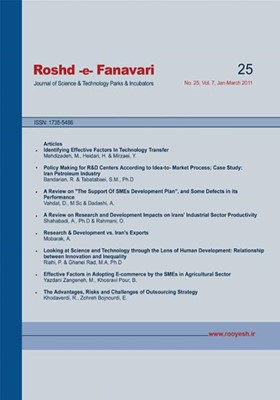-
-
List of Articles
-
Open Access Article
1 - The identification factors of effective in transfer of technology
Mahmood Mahdizadeh Hadi Heydari Ghare bag Yaser Mirzaei -
Open Access Article
2 - Policy Making for R&D Centers According to Idea to Market Process; Case Study Iran Petroleum Industry
Seyed mahameddin Tabatabaei -
Open Access Article
3 - A Review Of "The Support Of SMEs Development Plan", And Some Defects Of the Execution
Davood Vahdat alireza dadashi -
Open Access Article
4 - The Investigation of the Effect of Research and Development on the Iran׳s Industrial Sector Productivity
Abolfazll Shahabadi Omid Rahmani -
Open Access Article
5 - Research & Development vs. Iran's Exports
Asghar Mobarak -
Open Access Article
6 - Looking at Science and Technology through the lens of Human development: Relationship between innovation and inequality
Parisa Riyahi Mohammad Amin Ghanee Rad -
Open Access Article
7 - Components affecting the adoption of electronic commerce by the small and medium enterprises in the agricultural sector
Maryam Yazdani Zanganeh Bahman Khosro pour -
Open Access Article
8 - The Advantages, Risks and Challenges of Outsourcing Strategy
Rohollah Khodaverdi Ehsan Zohre bojnordi
-
The rights to this website are owned by the Raimag Press Management System.
Copyright © 2017-2026







